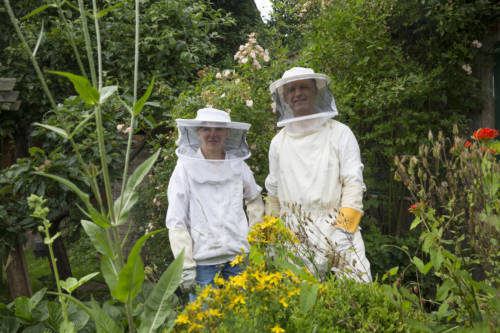
Generational Gardening in Glücksburg, The Bounty of the Baltic
On a recent drive to one of the Baltic Sea’s wild beaches, I had the distinct pleasure of passing through “Glücksburg” (which means “Castle of Fortune”), where a Danish king once built his abode on the ruins of a convent amidst a paradise of water and birds.
I stopped my car at a house that shone with the many colors of its flowers, and took a peak over the garden fence to see people in beekeeper suits, who I immediately sought out in hopes that they could tell me something interesting about their garden.
Upon my ringing the doorbell, an elderly man opened the door.
Heinz Welschoff lives with his wife, Adelheid, in this small house, which her family has inhabited for many generations. The house dates back to 1860, a time when Glücksburg had not yet come into existence. The floral splendor in front of the house continues into the garden at its rear, in colors that grow more progressively more intense and rugged.
The Welschoffs, I learn, have a special relationship with nature. The plants in their garden may seem wild and disordered, but they are not here by accident; each plant tells its own story. When Adelheid was a child, her mother had a habit of collecting plants whenever they went on a trip or made new friends.
Some of the students who gave Adelheid the plants they found have since passed away, but their flowers live on and continually cover new ground in the garden.
Adelheid has kept this tradition with her husband. Together, they’ve added wild teasel, which comes from their holiday home in Normandy, and they’ve grown hydrangea from the clippings they were given by a family they met on a trip to Wendland. (Given the success of these previous acquisitions, the couple even made it a point to bring a small shovel everywhere they went.) Adelheid used to be a primary school teacher, and her students used to bring her plants they found. Some of these students have passed away, but their flowers live on and continually cover new ground in the garden. Every year the blossoming is a little different.
Their son Alexander and his wife Brigit currently practice apiculture, which they began only two years ago– these are the beekeepers I saw. They got into beekeeping after worrying about the low yields of their fruit trees and discovering the cause: “Colony Collapse Disorder,” which is known to lead to significant losses of bee colonies. Alexander responded by taking a course on beekeeping and bought offshoots of hives from other beekeepers. In his first year, the success was manifest in his fruit trees’ abundant yields.
Today, Alexander and Brigit have five hives, and they’ve even sold a branch. Twice a year they harvest their honey. They process the beeswax left over as a byproduct into candles. But, despite their entrepreneurial success, beekeeping remains a hobby for the Wellschoffs. The bees benefit greatly from the wild and colorful garden that the elder generation planted: they buzz busily all about it. The Wellschoffs say that ever since they started to keep bees for themselves, they began making more of a conscious effort to find plants suitable as bee-food. That means color, fragrance, and above all: variety. Every now and then they add a souvenir to their parents’ album of flowers.










































